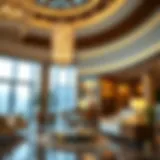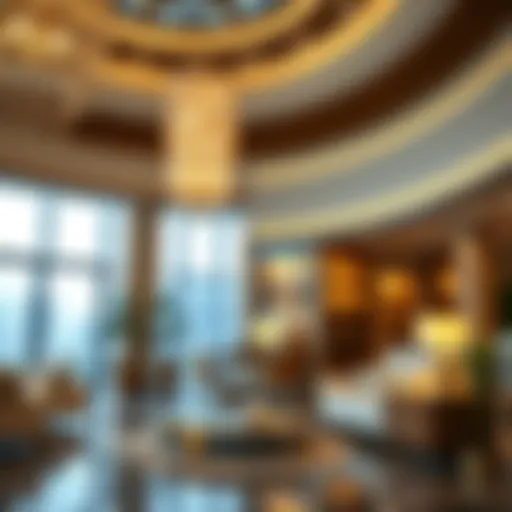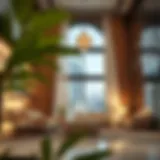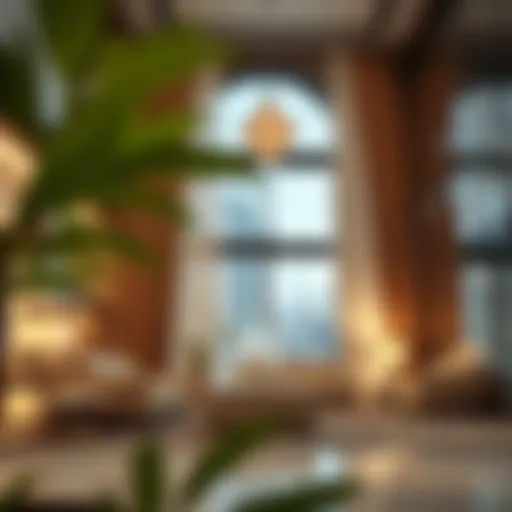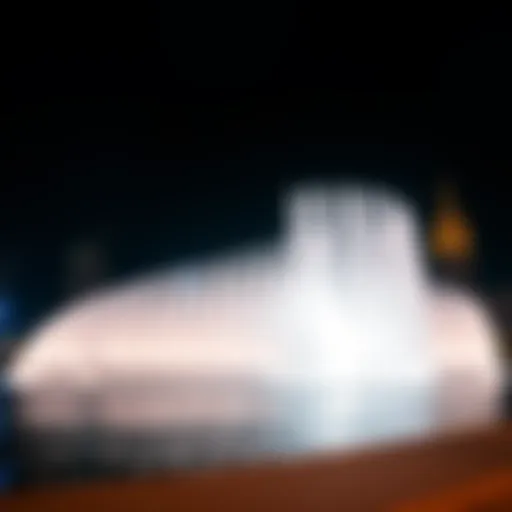Exploring the Unique Architectural Styles of UAE Houses
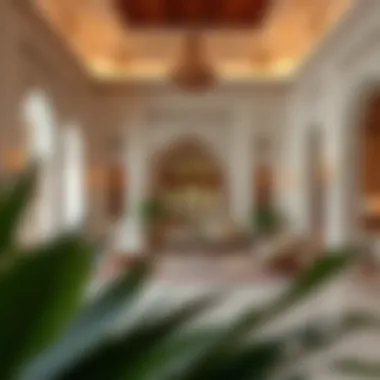

Intro
The United Arab Emirates, with its sumptuous blend of tradition and modernity, paints a fascinating picture when one looks at its residential architecture. Houses here don't just provide shelter; they narrate stories, chronicling the cultural transitions and influences that have shaped the nation over centuries. While one might think of glass towers and opulent villas as staples in Dubai and Abu Dhabi, a deeper dive reveals a rich diversity that encompasses everything from time-honored styles to innovative modern designs.
Architecture in the UAE is not merely about aesthetics; it mirrors the social fabric and economic dynamics of its regions. It's a dance of windswept dunes, coastal allure, and urban sophistication.
In this exploration, we will traverse through different architectural forms, focus on significant trends in the housing market, and uncover the motivations behind new constructions and urban development. This guide serves not just the casual observer, but also aspiring homebuyers, seasoned investors, and anyone looking to grasp the essence of UAE’s real estate evolution.
The narratives told through the architectural landscapes of the UAE are compelling; they reveal how globalization, cultural heritage, and technological advancements intertwine. Moreover, understanding the future trajectory in real estate is key for buyers and investors aiming to navigate this complex and colorful market.
Let’s embark on this comprehensive journey to understand the myriad elements that shape home designs in the UAE, starting with the current market insights.
Foreword to UAE Housing
Housing in the United Arab Emirates is not just a matter of shelter; it reflects an intricate network of cultural, historical, and economic threads. This introduction sets the stage for an exploration of how the UAE's diverse architectural landscape has evolved over the years. Understanding the nuances of housing in this vibrant region provides valuable insights not only for potential homebuyers and investors but also for expatriates considering a change in residence.
When diving into this topic, several elements surface that warrant attention. Firstly, the architectural diversity here acts as a living gallery of evolution. From traditional mud-brick homes to towering skyscrapers, each style tells a story rooted in both past traditions and modern aspirations.
Moreover, the socioeconomic fabric of the UAE is intricately woven into residential designs. One might say the buildings are like fingerprints, unique to each emirate, reflecting local values and lifestyles. Those looking to invest or buy homes here will soon find that understanding this diversity can influence their decisions immensely.
Another point of consideration is the sustainability initiative sweeping the region, alongside the desire to incorporate modern technology into living spaces. The sentiments around eco-friendly homes resonate deeply with the population aiming for a balance between luxury and environmental responsibility.
Overview of Architectural Diversity
The architectural scene in the UAE ranges from time-honored styles to avant-garde designs. Each construction type narrates a tale, reflecting the cultural amalgamation present in this rapidly developing country. Let's break down some noteworthy aspects of this diversity:
- Traditional Roots: The influence of Bedouin heritage profoundly shapes many historic buildings.
- Modern Influences: Contemporary architectural trends often pull inspiration from international styles, showcasing a blend that is distinctly local yet globally appealing.
- Sustainability Focus: New designs factor in climate considerations, using materials that provide insulation against the sweltering heat.
Furthermore, the integration of local elements while borrowing global influences demonstrates a unique capability for fusion. A prime example can be found in cities like Dubai and Abu Dhabi, where you can spot traditional wind towers sitting alongside modern glass facades.
As housing trends continue evolving, so does the landscape of architectural designs in the UAE. In the sections that follow, we'll explore traditional Emirati houses, contemporary urban homes, and the compelling journey toward sustainability in housing initiatives.
Traditional Emirati Houses
The significance of traditional Emirati houses in the narrative of UAE's architectural landscape cannot be overstated. These homes are not just structures made of concrete and stone; they embody the essence of a culture that has evolved over centuries. Each house tells a story of the past, reflecting the values, climate, and social dynamics of the Emirati people. Their designs, notably adapted for the harsh desert environment, reveal ingenious solutions to comfort and sustainability, thus providing a window into the life of earlier generations.
Barjeel - The Wind Tower
Among the most notable features of traditional Emirati architecture is the Barjeel, or wind tower. This striking element is designed to capture the breeze and direct it down into the living spaces. In a region where temperatures can soar, the Barjeel represents a masterful blend of functional design and aesthetic appeal.
Historically, these towers were constructed with varying heights and openings, allowing for the most effective ventilation. Families living in homes with Barjeel benefited from cooler temperatures indoors, showcasing how traditional knowledge thrived before modern air conditioning.
- Cultural Importance: The Barjeel extends beyond mere functionality; it serves as a cultural marker, symbolizing community and adaptation.
- Design Variations: Different regions within the UAE developed their own unique interpretations of the Barjeel, illustrating the diversity of Emirati heritage.
Many modern architects in the UAE now draw inspiration from the Barjeel, integrating its principles into contemporary designs. This not only preserves a crucial aspect of traditional architecture, but also underscores the importance of blending history with modern living.
Falaj - The Irrigation System's Influence
The Falaj irrigation system has profoundly shaped traditional housing in the UAE, as its presence aligns closely with the ancient needs for water management and agriculture. This traditional method of channeling water from underground springs to farmlands and homes influenced the layout and location of many Emirati houses.
The architecture around the Falaj system often includes gardens or farms as extensions of the home, demonstrating a connection to the land.
- Water Management: The Falaj system highlights the community's understanding of sustainable practices crucial in arid climates.
- Architectural Adjustments: Home layouts were strategically designed to optimize access to these water channels, showcasing an inherent respect for resources.
Most locals still recognize the Falaj as more than just an irrigation method; it is a practice that binds communities and connects them historically. The Falaj becomes an integral character in the environment within which traditional houses were constructed, offering both practical and cultural significance.
Adapting these elements into the current context while respecting their historical roots remains a challenge, yet it is essential for preserving Emirati culture as a notable facet of the UAE’s evolving real estate landscape.
Contemporary Homes in Urban Areas
When examining the housing landscape in the United Arab Emirates, contemporary homes in urban areas stand out for their striking modernity and functional design. These homes symbolize an evolving identity where tradition meets modern conveniences. As urbanization burgeons in cities like Dubai and Abu Dhabi, there is a noticeable shift towards contemporary architectural styles that offer comfort, luxury, and functionality for an increasingly diverse population.
Modern Apartments and High-Rise Buildings
Contemporary living in urban areas often translates to high-rise buildings and modern apartments. These structures not only rise above the skyline but also the expectations of homebuyers. They are tailored to meet the needs of a busy lifestyle common in metropolitan settings.
- Space Efficiency: Urban living is characterized by limited space. Tall buildings accommodate more families in less land area, making them an ideal solution.
- Amenities: Many modern apartments come with various amenities like gymnasiums, swimming pools, and community parks, enhancing the lifestyle of residents.
- Design Elements: Architectural features such as large windows, open floor plans, and eco-friendly materials are now staples, promoting light and space.
"The architectural design of modern apartments tells a story; it's a narrative of aspiration intertwined with the realities of urban living."
With the rise of social media, these apartments often become trendy spots for influencers and young professionals looking for picturesque backdrops for their online presence.
Luxury Villas and Signature Designs
In stark contrast to the high-rise apartments are the sprawling luxury villas that dot the emirate landscapes, especially in areas like Emirates Hills or Dubai Hills. These homes are not just structures; they are statements of status and personal style.
- Privacy and Exclusivity: Luxury villas offer spacious designs and extensive outdoor areas, ensuring that residents can enjoy their privacy away from the hustle and bustle of city life.
- Custom Designs: Many homeowners seek to invest in unique and bespoke architectural designs, allowing them to express individuality in ways that high-rise living cannot provide.
- Integration of Nature: These villas often incorporate landscaped gardens, private pools, and outdoor living areas designed to merge the indoors with the natural environment.
Modernity in these luxury villas does not overshadow the essence of Emirati culture. Many features still nod to the traditional elements, creating homes that are harmonious with their surroundings.
Sustainable Housing Initiatives
Sustainable housing initiatives have taken center stage as the cornerstone of modern architecture in the UAE. This approach doesn't just align with global environmental goals but also reflects the local culture's deep-rooted respect for nature. By embracing sustainable practices, the UAE is paving the way for a resilient future, addressing climate challenges while ensuring comfort and safety for its residents.
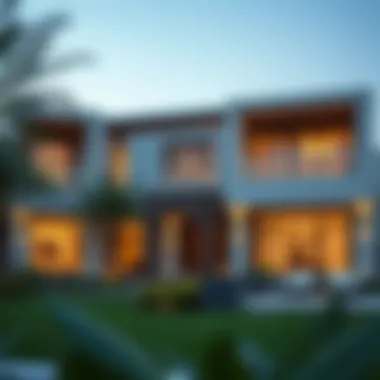

The shift towards sustainability is not merely a trend; it is a necessity in a region that grapples with rapid urbanization and dwindling natural resources. Building homes that are eco-friendly translates into reduced energy consumption, lower carbon footprints, and the preservation of water resources. Such initiatives often incorporate renewable energy sources, efficient insulation, and sustainable materials, making them not only practical but also economically prudent in the long run.
Growing Trend of Eco-Friendly Homes
The growing trend of eco-friendly homes in the UAE showcases the blend of architectural innovation and environmental responsibility. This sector is booming as more homebuyers opt for designs that prioritize sustainability. Here are some notable features and benefits of these homes:
- Energy Efficiency: Many new residential projects are designed with energy-saving technologies like solar panels and energy-efficient appliances, which significantly cut down utility bills.
- Water Conservation: Homes often include modern irrigation systems and appliances that minimize water usage, essential in a desert environment.
- Local Materials: Using local materials not only reduces transport emissions but also supports local economies, fostering community growth.
- Smart Home Technologies: Many eco-friendly homes are equipped with smart home systems that monitor and manage energy use, providing real-time feedback to residents about their consumption patterns.
- Enhanced Quality of Life: Research indicates that homes built with sustainable practices contribute to better air quality and overall well-being.
An excellent example of eco-friendly architecture in the UAE is the Sustainable City in Dubai. This community features solar rooftops, electric vehicle charging stations, and organic farms. It’s a living showcase of sustainability where residents can directly observe the benefits of living in an environmentally conscious home.
"Building sustainably is not just about saving the planet. It’s about securing a brighter, healthier future for the entire community."
As these eco-friendly homes gain traction, they not only address individual housing needs but also play a crucial role in shaping the cultural landscape of the UAE. They reflect the values of a society increasingly aware of its environmental impact and actively striving to promote green living. The need for sustainable housing initiatives is imperative and would be an essential consideration for investors, expatriates, and homebuyers looking to contribute positively to the community while enhancing their lifestyle.
The Role of Cultural Heritage
Architectural significance in the UAE encompasses more than just aesthetics; it intertwines with the cultural heritage that speaks volumes about the identity of the Emirati people. The buildings and designs reflect a rich tapestry of history, values, and traditions that have shaped the society over the years. Understanding the role of cultural heritage in the design of homes and buildings is vital for anyone looking to invest in or inhabit these spaces. It goes far beyond mere structure; it’s a reflection of a nation's ethos.
The architecture of the UAE is a mosaic of influences blending local traditions with modern innovations. This sense of cultural heritage provides the following benefits:
- Identity: Each home embodies the unique stories of the communities that inhabit them. It resonates with the local culture, reflecting the historical journeys of various tribes and families.
- Sustainability: By integrating traditional building techniques and materials, such as gypsum and coral, into contemporary designs, there is a greater emphasis on environmental responsibility.
- Community Engagement: Heritage-focused designs often involve local artisans and craftsmen, fostering an economic ecosystem that supports community-spirited initiatives.
Integrating Tradition with Modernity
In the quest for modernity, many architects and builders aim to bridge the past with the present. This integration is evident in homes that combine contemporary lines with traditional materials, striking a balance that honors the legacy of the region while catering to the needs of modern living.
Some notable aspects of this integration include:
- Design Elements: Features such as the Barjeel (wind tower) can be incorporated into high-rise structures, preserving its function of natural cooling while embracing avant-garde building techniques.
- Materials: The use of mudbrick or limestone, materials rich in local history, in modern constructions creates an atmosphere linking the homeowner to their roots.
- Cultural Spaces: Communities are increasingly incorporating shared spaces designed for celebration of traditions, from family gatherings to festivals, thereby fostering a sense of belonging.
"Cultural heritage isn’t just about preserving the past; it’s about forging identities for the future."
Urban planners are also taking note of the blend of styles, offering incentives for projects that respect heritage while pushing for innovative solutions to the growing housing demand. The role of cultural heritage in contemporary architecture is not only about creating beautiful buildings but also about shaping enduring communities that respect their roots while looking toward an exciting future.
In sum, the integration of traditional elements into modern homes offers a refreshing perspective. It emphasizes the importance of remembering the past in a region that is rapidly changing and expanding. Investors, expatriates, and homebuyers would do well to consider these aspects when navigating the diverse architectural landscape of the UAE.
The Influence of Foreign Designs
The architectural landscape of the UAE is a veritable potpourri of styles and influences, reflecting the country's rapid growth and its role as a global hub. The infusion of foreign designs has shifted the very identity of housing in the region. Understanding the impact of these designs is crucial, as it illustrates how the UAE has balanced its rich cultural history while embracing modernity.
A significant factor in this phenomenon has been the influx of expatriates from around the world, each bringing with them their own architectural preferences and cultural insights. This mix has not only contributed to the unique skyline of cities like Dubai and Abu Dhabi but has also created an environment where innovation thrives. The benefits of these foreign influences include enhanced creativity in residential design, improved living standards through contemporary solutions, and an enriched cultural tapestry that reflects diversity in living spaces.
Nonetheless, integrating these foreign styles comes with its own set of considerations. Issues such as maintaining cultural authenticity, climatic adaptability, and functionality need attention. Finding the right balance between preserving local architectural heritage and incorporating global trends is an ongoing dialogue within the UAE's design community.
Western Styles in the UAE
The western influence in UAE’s architecture is particularly visible in urban centers. High-rise buildings inspired by American and European designs have transformed skylines. Structures such as the Burj Khalifa stand as testament to this integration, showcasing sleek lines and glass facades that compete with the world's best.
Besides high-rises, townhouse communities and single-family homes often draw from suburban American designs. Features like spacious layouts and outdoor spaces catered to family living have permeated the market, appealing to both locals and expatriates. Moreover, architectural firms often partner with foreign consultants to blend modern aesthetics with local needs, producing unique residential models.
Incorporating elements like open-plan layouts and large windows for natural light aligns with contemporary lifestyles. The integration of smart-home technologies further reflects western innovations, altering how residents interact with their homes. There’s an evolution towards not just living spaces, but dynamic environments tuned to the needs of modern families.
Asian Architectural Elements
Asian design influences in Emirati housing are equally notable. With a substantial number of residents hailing from South Asia, the architectural styles seen in regions like India and Pakistan have made their mark. Traditional elements such as ornate carvings, vibrant color palettes, and expansive courtyards can be found in villas catering to this demographic.
The concept of feng shui, originating from China, emphasizes harmony and balance within living spaces, influencing building layouts. This perspective highlights an important intersection of aesthetics and ethics, where the environment is nurtured to provide comfort and serenity.
While adapting these styles, builders must remain sensitive to climatic conditions, ensuring that designs provide ample ventilation and shade against the sweltering heat. These adaptations can lead to homes that not only reflect the tastes of their residents but also respond effectively to environmental challenges.
It’s clear that the diverse influences of both western and Asian designs have woven a rich narrative of architectural evolution within the UAE, shaping homes that resonate with global citizens who call this region their home.
Understanding these architectural influences is vital for anyone looking to invest in the UAE real estate market. By appreciating how foreign designs have molded the residential landscape, investors and buyers can better navigate the complexities of housing options while recognizing the cultural nuances embedded in each style. The future of housing in the UAE will undoubtedly continue to be shaped by an ongoing dialogue between tradition and innovation.
Apartment Complexes and Suburban Living
The landscape of housing in the UAE is rapidly evolving, and apartment complexes along with suburban living have carved their own niche in this architectural narrative. These types of communities are not only vital for catering to the increasing population of expatriates and locals alike but also embody a unique lifestyle choice that reflects modern living trends.
As cities like Dubai and Abu Dhabi undergo continuous expansion, the need for efficient urban planning becomes paramount. Apartment complexes enable high-density living while maximizing land use, thus supporting the overall growth of urban areas. These complexes often offer a range of amenities, increasing their appeal among residents. From pools and gyms to parks and shops, modern apartment communities strive to incorporate lifestyle conveniences into their structures.
Other benefits of suburban living are notable too. Suburbs provide a different pace of life compared to bustling city centers. Families, in particular, are drawn to these areas for the promise of safer neighborhoods and educational opportunities. Additionally, the cost of living in suburban areas can be more favorable compared to prime urban locations, making it an attractive option for new homebuyers and investors looking for value.
This article delves into the importance of apartment complexes and suburban living in the UAE context, giving readers key insights into why these developments are essential in shaping housing trends and fulfilling the needs of a diverse populace.
Features of Modern Apartment Communities
Modern apartment communities in the UAE come with a variety of features designed to attract both families and individuals looking for conveniences at their doorsteps. Here are some standout characteristics:
- Smart Home Technology: Many newer apartments are equipped with smart home systems. This allows residents to control lighting, temperature, and security systems remotely, enhancing convenience.
- Recreational Facilities: Amenities like swimming pools, gyms, and even community halls are becoming the norm. These facilities foster a sense of community among residents, encouraging social interaction.
- Green Spaces: Developers are increasingly including parks and green areas within their projects. This not only improves aesthetics but also provides residents with an escape from the urban environment, contributing to a healthier lifestyle.
- Accessibility and Transport Links: Many apartment complexes are strategically located near public transport links, making commuting easier for residents who work in busy urban hubs. Close proximity to major highways is also a significant advantage.
- Community Engagement: Some modern communities organize events, activities, and workshops to promote engagement among residents. This helps create a vibrant community atmosphere, reinforcing the sense of belonging.
"In a survey, over 60% of urban residents in the UAE expressed a preference for living in well-planned apartment complexes that offer a blend of convenience, community, and quality of life."
The Rise of Gated Communities
The rise of gated communities in the UAE speaks volumes about the changing landscape of residential preferences. This trend isn’t just about cutting-edge architecture or luxury; it reflects deep-seated values related to security, privacy, and a desire for a layered sense of community. As urban areas expand rapidly, the demand for housing that provides both comfort and safety has surged, making gated communities a pivotal part of the modern UAE real estate scene.
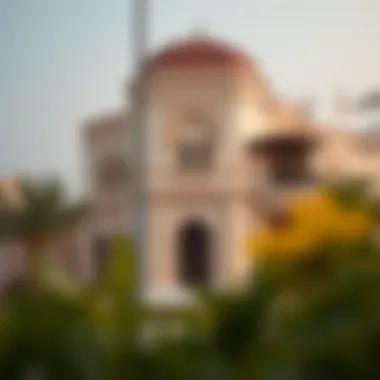

These enclaves often house diverse populations, appealing to expats, families, and local residents alike. However, they also raise questions about inclusivity and access, making this an intricate subject worth exploring. The notion of exclusivity can be both enticing and controversial, forcing us to consider what it means to live in a "gated" space in a nation known for its hospitality and openness.
Security and Exclusivity
At the core of gated communities is the promise of security. The allure of living behind secure walls is more than just psychological; it often translates into tangible benefits. Many of these communities offer 24/7 security personnel and surveillance systems, offering peace of mind to residents. In a region characterized by rapid development, where bustling city life contrasts with serene suburban retreats, it’s only natural that people seek shelters that assure their safety.
However, this focus on security brings up a complex issue—exclusivity. While living in a gated community can provide a haven, it also segregates residents from the wider community. This situation often leads to a duality; on one hand, the tight-knit atmosphere fosters friendships and a sense of belonging among neighbors. On the other, it could breed a disparity that undercuts the essence of the Emirati spirit of connection and hospitality. As the saying goes, "Good fences make good neighbors," but at what cost?
Amenities and Lifestyle Offerings
Alongside the security features, gated communities are often packed to the brim with amenities that cater to an upscale lifestyle. Parks, pools, gyms, and even small shopping centers can be commonplace, fostering a self-sufficient micro-community. For families, these features can simplify life; children can play freely, and families can enjoy recreational activities without venturing far from home. Specifically, leisure facilities and social spaces encourage harmonious interactions among residents and facilitate a busy lifestyle while retaining a sense of community.
Moreover, many gated communities position themselves strategically near key urban hubs, allowing easy access to both work and leisure without sacrificing tranquility. This balance of accessibility and comfort is a selling point for both real estate investors and potential homeowners. The convergence of lifestyle offerings creates a compelling case for why these communities are proliferating across the UAE.
In summary, the momentum behind the rise of gated communities reflects broader socio-economic trends in the UAE. As security, exclusivity, and lifestyle amenities continue to shape residential choices, the impact of these developments will undoubtedly inform future architectural and urban planning decisions. It’s a dance between the desire for privacy and the inherent value of community, underscoring the complexities of modern living in a rapidly evolving landscape.
The appeal of gated communities in the UAE illustrates a balancing act between safeguarding personal space and nurturing community ties.
Economic Factors Shaping Housing Trends
Understanding the economic factors shaping housing trends in the UAE is crucial for anyone involved in real estate, whether it be investors, expatriates, homebuyers, agents, or landlords. The housing landscape here reflects not just architecture but the region's economic dynamics. Changes in economic conditions can have a direct influence on housing markets, property values, and overall availability of housing options.
As the UAE experiences rapid economic growth—spurred by oil revenues, tourism, and a burgeoning service sector—the demand for housing naturally follows suit. With urban areas expanding and attracting more residents, both locals and expatriates are looking for suitable places to live. This makes economic stability an important consideration when evaluating housing options.
Impact of Economic Growth on Real Estate
Economic growth in the UAE primarily drives changes in the real estate sector. Some of the notable effects include:
- Increased Demand for Housing: As businesses flourish and the job market becomes vibrant, more individuals are drawn to the country. This influx raises the need for residential spaces, thereby amplifying demand across various housing categories—from luxury villas to modern apartment complexes.
- Rising Property Values: With the heightened demand comes the inevitable rise in property prices. As affluent expatriates set their sights on living within city centers, it becomes commonplace for property values to soar, often outpacing inflation.
- Investment Opportunities: A growing economy typically invites local and foreign investments into real estate, enhancing development projects and creating new residential areas. Investors often look for up-and-coming neighborhoods, which can yield high returns.
- Government Initiatives: Economic growth often leads governments to initiate policies aimed at sustaining housing demand. The UAE government has implemented various programs, such as the introduction of freehold property ownership for foreigners, which has opened up new avenues and motivated more purchases.
"The real estate market is a barometer of the economy; as the winds of economic change blow stronger, housing becomes a reflection of that vigor."
In short, economic factors are imprinted on the housing fabric of the UAE. The vibrancy of the market showcases an interplay between growth, demand, and governmental support, all of which come together to construct the complex narrative of the UAE housing landscape. As one navigates through these waters, awareness of the economic undercurrents can provide invaluable insights for making informed decisions in the ever-evolving real estate scene.
Government Regulations and Housing Policies
Government regulations and housing policies in the UAE play a crucial role in shaping the residential landscape. They not only define the parameters within which housing can be developed but also aim to protect the interests of all stakeholders involved. From expatriates to real estate investors, the laws designed in this sector directly impact accessibility and affordability of homes.
One of the significant elements of these regulations is the Land Use Law, which establishes zones that determine where residential properties can be built. This framework is essential as it manages urban sprawl, ensuring that different areas maintain specific functions. Regulations regarding building heights and density also fall under this umbrella, creating a harmonious balance amidst diverse housing projects.
Another critical policy is the transparency requirements for property transactions. The UAE Real Estate Regulatory Agency provides a clear framework ensuring that all transactions, be it for rental or purchase, are documented appropriately. This helps to combat fraud and encourages a trustworthy environment for investors and buyers alike.
Benefits of Government Regulations
- Stability in the Market: Regulations help in maintaining an orderly marketplace, which is essential for long-term investments.
- Consumer Protection: Policies in place, such as those governing rental agreements, assure that tenants are treated fairly and landlords adhere to standards.
- Encouragement of Sustainable Practices: The government promotes eco-friendly development methods, pushing developers to consider sustainability alongside profitability.
However, navigating these regulations can be challenging for newcomers. Often, there are cultural nuances and bureaucratic complexities that can cause confusion. Understanding these regulations is a prerequisite for expatriates and homebuyers looking to invest in the property market.
"A well-informed buyer is a powerful buyer; knowing the regulations is pivotal in making sound decisions in the housing market."
Considerations Regarding Housing Policies
Homebuyers should also be aware of recent amendments in policies affecting ownership rights. For example, laws permitting foreign ownership in designated areas have opened gates to a larger pool of potential buyers, enhancing the housing market's diversity.
Additionally, policies may evolve based on the country’s socio-economic conditions. Keeping abreast of these changes can mean the difference between making a profitable investment or a regrettable oversight.
Understanding these nuances can be a double-edged sword; while it can provide advantages, it may also require significant research and advice from real estate professionals. Overall, being equipped with knowledge on government regulations is invaluable for navigating the dynamic housing landscape.
For further insights into housing laws and regulations, check resources like
- Wikipedia on UAE Real Estate Law
- UAE Government's official real estate page
- Middle East Eye - Housing in the UAE
Understanding the legislative framework is key for anyone considering a stake in UAE's housing market.
Future Trends in UAE Housing
Understanding future trends in UAE housing is crucial as it shapes not only the architectural landscape but also reflects broader societal shifts and economic transformations. The demand for innovative, sustainable, and culturally resonant homes is rising. With rapid urbanization and increasing global attention, these factors drive a rethinking of what housing means in the region. This makes it a vital point of discussion for investors, homebuyers, and other stakeholders in the real estate sector.
The future looks to embrace several key elements:
- Sustainability: More energy-efficient designs incorporating renewable resources such as solar panels, green roofs, and efficient insulation systems are at the forefront. This reflects a global trend toward reducing carbon footprints and promoting environmental awareness.
- Smart Technology: Homes equipped with automation systems that manage lighting, climate, and security are becoming more commonplace. Buyers, especially younger generations, prioritize technology that enhances their living experience.
- Affordable Housing: There’s a growing market for affordable housing solutions that maintain quality but remain accessible to a larger segment of the population. Housing policies focusing on this aspect could foster a more balanced community.
- Cultural Preservation: While modern designs take precedence, an underlying trend is the integration of traditional Emirati elements into newer constructions, ensuring that cultural identities remain intact.
All these elements align to shape the UAE’s architectural narrative moving forward, balancing tradition with modern demands in what can often feel like a high-stakes game.
Emerging Architectural Innovations
The horizon of emerging architectural innovations in the UAE is painted with diversity and imagination. These innovations aren't merely aesthetic; they encapsulate advanced technology and sustainable practices that cater to the lifestyle of a rapidly evolving society.
One predominant theme is the biophilic design approach, which seeks to reconnect residents with nature. This can be seen in avenues where green spaces are artistically integrated with residential complexes, promoting a healthier living environment. Buildings are designed to incorporate natural light and ventilation, greatly enhancing the residents' quality of life.
Noteworthy Projects
Several projects stand out in this regard:
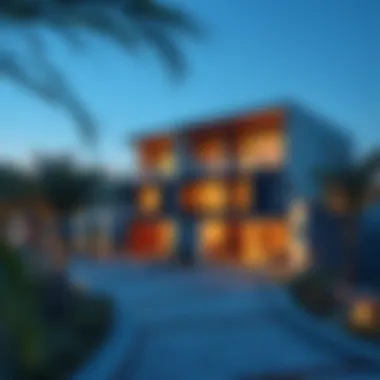

- The Sustainable City: Located in Dubai, this development emphasizes eco-friendly living. The community features solar energy production, extensive green spaces, and a zero-waste philosophy.
- Masdar City: An ambitious venture aiming to be a hub of renewable energy and sustainable living, incorporating innovative materials and designs that minimize energy consumption while fostering a sense of community.
"Architecture is a reflection of society. As the UAE continues to evolve, so too must its buildings and homes, ensuring they serve their inhabitants effectively while respecting the past."
The increasing focus on vertical living—high-rise apartments with communal facilities—also marks a shift in housing preferences, particularly in urban centers.
Culmination
As we peer into the crystal ball regarding the future of housing in the UAE, it’s evident that architectural innovations will be crucial. The synergy between technology, sustainability, and cultural identity will define how homes are constructed and lived in, encouraging a more thoughtful approach to housing solutions. Stakeholders must remain vigilant, adapting to these trends to meet the demands of a rich, diverse population.
Impact of Tourism on Housing Demand
The flourishing tourism sector in the UAE has a profound effect on housing demand, catalyzing both short-term and long-term residential needs. As a bustling hub for international travelers, the UAE attracts millions of visitors each year. This significant influx creates a unique scenario where housing must adapt quickly to cater to tourists, making it an essential focus for our discussion.
- Market Dynamics
Tourism plays a pivotal role in shaping the real estate market. With its vast array of luxurious hotels, unique attractions, and cultural experiences, the UAE has become a leading destination for short-term visitors. Properties that can accommodate these visitors—such as vacation homes and short-term rentals—soften the acute demand for traditional housing while adding vibrancy to neighborhoods. - Financial Benefits for Homeowners
The rise of platforms like Airbnb and Vrbo allows property owners to capitalize on this demand. Homeowners who invest in vacation rentals can generate significant income, especially during peak tourist seasons. This provides a valuable revenue stream while simultaneously boosting the local economy. - Regulatory Considerations
However, with these benefits come challenges. Local governments are increasingly scrutinizing short-term rental practices to ensure they're safe and properly managed. Legislation is continuously evolving in response to concerns from residents about noise, security, and the impact on community dynamics. Owners must stay informed about regulations to maintain compliance. - Changing Neighborhood Landscapes
In areas like Dubai Marina and Yas Island, the presence of vacation homes can alter the neighborhood character. An international flair emerges as these areas attract a diverse crowd, leading to unique cultural exchanges. However, there is a delicate balance between preserving local identity and embracing the cosmopolitan nature that tourism brings.
"Regulations on short-term rentals aren’t just red tape; they protect neighborhoods while allowing property owners to thrive."
Short-Term Rentals and Vacation Homes
As previously mentioned, short-term rentals are a rising star in tourism-induced housing demand.
- Types of Rentals
These can include everything from lavish villas with stunning views to cozier apartments in bustling city centers. Each type caters to different travelers, be it families looking for space or solo adventurers seeking a lively area. - Location Preferences
Tourists often desire proximity to major attractions—such as the Burj Khalifa, the Louvre Abu Dhabi, or the shopping experiences at the Dubai Mall. Properties within reach of popular sites often command higher prices, showing a lucrative potential for landlords. - Amenities and Facilities
Rental properties that offer amenities—pools, gyms, or even a private beach—attract more tenants. In a crowded market, unique features can make or break a property’s desirability. - Sustainability Considerations
As travelers become more environmentally conscious, properties that showcase sustainable practices—like solar panels, water-saving fixtures, or recycling programs—might find themselves appealing to an eco-aware market segment.
This intersection of tourism and housing demand creates a bustling market that necessitates ongoing adaptation and vigilance. The dynamic nature of this field not only exemplifies the UAE's housing evolution but also highlights the influence of cultural shifts, economic imperatives, and the global stage.
Cultural Significance of Housing Styles
In the United Arab Emirates, the diversity of housing styles encapsulates the essence of its cultural richness and socio-economic evolution. Each architectural design, whether it emanates from traditions or modern innovations, reflects layers of history and identity, marrying the past with contemporary aspirations.
Understanding the Connection to Heritage
The connection between housing styles and cultural heritage in the UAE is profound. Houses are not merely structures; they are a commentary on the social behavior, traditions, and lifestyle of Emirati citizens. A myriad of influences from nomadic Bedouin architecture to opulent palaces showcase this relationship.
- Embodiment of History: Traditional homes like the Barjeel serve as more than just physical spaces; they symbolize the ingenuity of past generations in adapting to the harsh climate. The Barjeel, or wind tower, is an architectural feature that not only provides ventilation but also represents a commitment to sustainable living long before the term became fashionable.
- Cultural Representation: The architectural choices made today often echo a desire to retain cultural ties. For instance, some modern homes incorporate design elements like the Mashrabiya, a type of projected latticework, that invites nature while providing privacy. This intricate design reflects the historical emphasis on family, community, and social interaction.
- A Reflection of Identity: Furthermore, the styles of housing can be seen as an expression of national pride. In regions where modern villas and luxurious estates exist alongside traditional homes, one can witness a narrative of progress. The juxtaposition reveals how heritage and modernity can coalesce, fostering a sense of identity that respects the past while paving the way for future innovations.
"The essence of a house goes beyond its walls; it embodies the heartbeat of its people and the legacy of its land."
Ultimately, understanding the cultural significance of housing styles in the UAE is crucial for anyone involved in real estate or investment. Recognizing how architecture influences social dynamics can lead to better appreciation and insightful decision-making when navigating the local market. Additionally, appreciating these cultural intricacies can enhance connectivity with potential homebuyers, expatriates, and investors looking for not only a property but a piece of the Emirati experience.
For more insights, consider reading about Bedouin Architecture or exploring local news features on historic homes in UAE: Gulf News.
This relationship between housing styles and cultural significance offers a rich avenue for exploration, revealing stories that go beyond bricks and mortar.
Case Studies of Iconic Homes
Exploring the landscapes of housing in the UAE is incomplete without examining its iconic homes. These structures embody not just architectural prowess but also reflect the cultural and societal evolution of the country. Each case study offers a window into the complexities of design influenced by tradition, modernity, and the environment.
From grand villas to minimalistic apartments, each home has a story, showcasing the interplay between aesthetics and functionality. Analyzing these architectural gems can provide insights into what drives demand, influences taste, and shapes real estate trends in the region.
Notable Architectural Projects
Among the most talked-about architectural projects is the Burj Al Arab, often dubbed the world's only seven-star hotel. Its unique sail-like design is a hallmark of luxury, making it a must-see for tourists and a key feature of the Dubai skyline. However, it’s not solely about grandeur. This project has set a benchmark for hospitality architecture, influencing new builds across the region.
Another significant example is the Masdar City, which represents the move towards sustainable living. This planned city focuses on minimizing ecological footprint while embedding advanced technologies. Residents and visitors alike experience a lifestyle that marries comfort with environmental consciousness, carving a niche in the global conversation about eco-friendly designs.
Moreover, the VILLA 3 designed by Gigi BBS offers another fascinating study. Nestled in the heart of Abu Dhabi, this residence integrates modern open-plan aesthetics with traditional Arabian styles. The villa uses large glass windows to engage with its surroundings, promoting a connection to the outside—especially necessary in the region's arid climate.
"The architecture of a home must reflect the values and lifestyle of its occupants, making it not just a design but a statement about who we are."
These homes are not just buildings; they are narratives of a nation in transformation. They speak volumes about the desires of their inhabitants and the possibilities presented by modern architecture. Each project serves as a touchstone in the rapidly evolving landscape, showcasing how the traditional roots of UAE design continue to flourish in contemporary formats.
As we look to the future, it becomes clear that these case studies will play an increasingly essential role in meeting the needs of a diverse population. Amidst the blending of cultures and ideas, they reflect a unique harmony—a bridge between what was, what is, and what could be.
By evaluating the distinct features of these notable projects, one can appreciate not only the visual aspects but also the deeper implications they hold for the UAE's identity and real estate landscape.
Concluding Reflections
As we bring our exploration of the diverse architectural landscape in the UAE to a close, it's valuable to reflect on the myriad influences that shape housing in this rapidly developing region. Understanding these factors can illuminate the broader trends that govern real estate, as well as cultural and social dynamics, which are deeply intertwined with the way people live.
One crucial element to consider is the cultural heritage that continues to inform modern designs. Traditional styles, like the Barjeel and the Falaj, aren’t mere relics of the past; they incorporate elements that resonate with contemporary lifestyles. A house is not just a shelter, but a representation of identity, community values, and aspirations.
The balancing act between preserving traditions and embracing innovation is paramount. As expatriates and investors flock to the UAE, bringing with them different influences and demands, the housing market responds fluidly. A mix of modern skyscrapers and eco-friendly homes is blooming alongside traditional structures, creating unique neighborhoods that represent a melting pot of cultures. This not only augments the overall aesthetic appeal but also serves to attract tourism and business.
Furthermore, regulations and government support in sustainable housing can inspire critical progress. As the UAE lays the groundwork for future developments, aligning with global trends in sustainability and technology will only strengthen its position as a leader in real estate.
In moving forward, stakeholders must keep an eye on emerging architectural innovations, continuously attuning themselves to shifts in consumer preferences. This adaptability will be crucial in catering to a market that seeks luxury as much as cultural authenticity.
In summary, the future of housing in the UAE holds remarkable potential. The ongoing blend of tradition, modern technology, and cultural influences lays a fascinating foundation for growth.
"The UAE's architectural evolution does not exist in a vacuum; it mirrors its society's transformation and aspirations."
The Future of Housing in the UAE
Looking ahead, the prospects for housing in the UAE are brimming with possibilities. The real estate landscape continually morphs as it responds to various influences, such as emerging technologies, environmental concerns, and shifting demographics.
Some directions worth considering include:
- Smart Home Technologies: As digitalization accelerates, smart home features will become increasingly standard, offering enhancements in convenience and efficiency. Homebuyers are likely to favor homes equipped with automated systems for lighting, climate control, and security.
- Sustainability Practices: A focus on eco-friendly practices is gaining traction. Green building designs that incorporate energy-efficient systems, sustainable materials, and landscaping will not only meet government regulations but also attract environmentally-conscious consumers.
- Cultural Fusion: The convergence of different cultures will continue to inspire architectural styles, bringing forth designs that integrate various aesthetics. Expect to see more hybrid models that combine Western minimalism with Middle Eastern elegance.
- Urban Planning: Cities like Dubai and Abu Dhabi will likely advance their urban planning strategies to accommodate an increasing population and enhance the quality of life. With features like walkable communities and integrated public transportation systems, future developments promise to foster community spirit.
Investors and homebuyers need to pay attention to these trends, as they will significantly affect property values and market dynamics. Those who stay ahead of the curve will find opportunities rife for the taking in the UAE’s evolving housing market.




